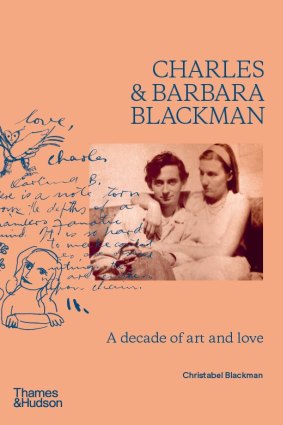
ART
Charles & Barbara Blackman: A Decade of Art and Love
Christabel Blackman.
Thames & Hudson, $59.99
It would be easy to jump to the conclusion that a book dedicated to a decade in the life of a couple, written by their child and based on the discovery of a cache of old love letters, could be a bit of a navel-gazer. Even if that couple are feted for their contributions to Australian cultural life, the premise might suggest that this could be one for dyed-in-the-wool fans.
However, Charles & Barbara Blackman: A Decade of Art and Love transcends those assumptions. Christabel Blackman has used that small treasure trove of letters as a leaping-off point, transporting the reader back in time and producing a richly cinematic tale of Australia’s evolving cultural life in the 1950s.

Charles and Barbara Blackman in 1977 at the opening of an exhibition of his paintings.Credit: South China Morning Post via Getty Images
The book’s design honours its epistolary origins, with a cover embossed with a photograph of the couple curled up together overlaid with Charles’ handwriting and ink drawings, and endpapers featuring photographs of the envelopes containing the letters sent from Charles to Barbara when he was pursuing the artist’s life in Melbourne as she, an emerging writer and poet, completed studies in Brisbane.
Thin, matte paper stock suggesting letter-writing stationery features marginalia including never-before-seen sketches by Charles Blackman along with the couples’ handwriting, official documents and more than 160 of Blackman’s paintings.

Credit:
The decade in question commences at the beginning of the couple’s relationship (they were married from 1952 to 1978) and concludes with the year of the author’s birth (with her own anecdotes drawn from conversations with her parents sprinkled judiciously throughout).
The book embarks on a whistle-stop biography of the two protagonists to preface this period, and Christabel Blackman’s matter-of-fact descriptions of the trials and tribulations of her family’s early stories provides an insight into the circumstantial difficulties of life in early 20th-century Australia – notably for many women, children and returned servicemen.
The book explores how Barbara and Charles Blackman became the keystones to each other’s lives, supporting each other emotionally and practically – Charles after a deprived childhood, Barbara with deteriorating vision. The content of the letters themselves is poetic, dramatic and often achingly heartfelt, written urgently and posted randomly. But there is only one letter written by Barbara, the rest are by Charles.









 Add Category
Add Category